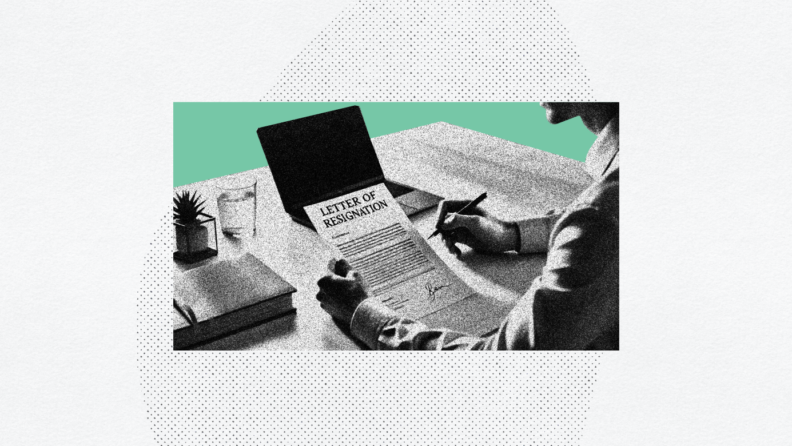Writing a resignation letter can feel awkward or stressful, but it doesn’t have to be. With the right approach, you can exit your role gracefully while maintaining professional relationships. A well-written resignation letter ensures clarity, professionalism, and goodwill as you transition to your next opportunity.
In this article, I’m going to take you through what goes into a well constructed and professional resignation letter. I’ll also try to help you find a bit of light heartedness in what can sometimes be a difficult task.
Why a Well-Written Resignation Letter Matters
A resignation letter is more than just a formality—it sets the tone for your departure. Even if your employer knows your about to quit, you still want to get this right.
Jess Smith, Chief People Officer at Hays Staffing and Recruiting and a former Head of Talent Intelligence at Amazon advises: "A resignation letter might be kept on file in a company for years , depending on their storage rules. So you want to be careful what you say."
By following a structured approach, you can make this process smooth and stress-free.
What to Put in a Letter of Resignation
Some of this is going to seem a bit obvious, but in the interest of not missing any details, I’m going to lay out the structure of your letter of resignation. Getting it right could mean the difference between your employer being someone you can rely on for a reference or a burned bridge.
That said, don't try to sugar coat it or worry about upsetting folks. If it's your time to go, go with a clear conscience.
"Be genuine," Karen Weeks, founder of Shine at Work said. "Don't make it overly flowery or so complementary of something or someone if that is not your personality. If your manager really was amazing, absolutely give them a shout out and share one thing you will take with you because of them. But don't go overboard just because you don't want to burn a bridge or worried someone will be mad that you are leaving."
Key elements to include
To craft a strong resignation letter, include the following elements:
1. Clear statement of resignation
Be direct and unambiguous in stating your intent to resign. You might be tempted to try and start explaining your reasoning for your departure. Don’t. Just get to the point, there will be plenty of time to talk about the what and whys in your exit interview.
- Example: “Please accept this letter as my formal notice of resignation, effective [last working day].”
2. Last working day
Specify your final working day to provide clarity for transition planning. Ideally you want to give them as much notice as possible, but two weeks is all that you should consider a requirement. It can always be done, as perhaps your new employer has demanded you start sooner, but do everything in your power to provide a full two weeks.
- Example: “My last day with [Company Name] will be [specific date].”
3. Expression of gratitude
Show appreciation for the experience and opportunities you had in your role.
- Example: “I am grateful for the support and professional growth I’ve experienced at [Company Name], especially [mention a positive experience].”
4. Offer to assist with transition
Reassure your employer that you’re willing to help with the transition.
- Example: “I am happy to assist in training my replacement or briefing colleagues who will be picking up my work, and ensuring a smooth handover of my responsibilities.”
5. Contact information
Provide updated contact details for future communication. You just never know. Come tax time you may need additional documentation or to have something corrected. An avenue for connecting needs to be available to you and the HR team.
- Example: “You can reach me at [your email] for any necessary follow-up.”
Tips for professionalism
Your departure will shock some people. That doesn't mean you should actively want it to shock people.
"Don't have your resignation letter be the way your company is finding out you are leaving," Weeks said. "Talk to someone live first. It can be your manager or HR, whoever you feel most comfortable with, but it is not the best look when we both find out via email that someone is resigning. One of us will also immediately call you, so you are going to have to talk to us sooner rather than later. So the correct professional move is to chat with someone, then follow up with the resignation letter."
Your colleagues are going to be the people most impacted by your departure. Giving them time to wrap to prepare their workloads to absorb yours or reach out to people they know who might be a good fit for replacing you is more than a courtesy.
"Don’t assume your letter will be sufficient to let people know you’re leaving," Smith said. "Proactively reach out to colleagues after aligning with your manager on the comms plan to keep in touch and bridges in tact. You never know how you will use this network in the future."
Everyone approaches this situation differently, but regardless of your generation, tenure or position at the company, here's a couple things you want to get right.
- Tell your manager and resign verbally first to avoid burning bridges.
- Keep your letter concise and polite—avoid unnecessary details.
- Maintain a professional tone, even if you’re leaving under difficult circumstances.
- Tailor the language based on your relationship with your manager.
What Not to Put in Your Resignation Letter
There are certain things you want to avoid in the resignation letter. Some of these might be tempting to include, especially if you have a grievance with the employer you're leaving, but there's a time and a place.
1. Unnecessary details
Do not overshare personal reasons for leaving, such as conflicts with coworkers or management dissatisfaction. If you have an exit interview, you can open up about these things more at that time.
"Don’t use the resignation letter to 'out' someone in the company," Smith said. "If you have feedback you want to leave behind about your experiences, the resignation letter isn’t the place to do it. Request an exit interview with HR live to formally document your feedback."
- Example to Avoid: “I can’t stand working with [coworker’s name] anymore.”
2. Negative comments or criticism
Avoid complaints about leadership, company policies, or team dynamics.
- Example to Avoid: “I’m leaving because this company doesn’t value employees.”
3. Overly emotional language
Remain professional and composed in your wording. Maybe the job has torn you down emotionally, but this isn’t the place to explain your feelings of burnout and disengagement.
- Example to Avoid: “This job has drained me mentally, and I just can’t take it anymore.”
4. Ambiguity about your decision
Make your resignation firm and clear. If you’re to the point of sending this letter, then you’re out the door. Don’t leave anything open to interpretation and, ultimately, misunderstanding.
- Example to Avoid: “I might leave soon, but I’m still thinking about it.”
5. Unreasonable demands or expectations
Save any discussions about benefits or compensation for an exit interview. If this is at the core of why you’re departing, that’s understandable, but this is not the place to express it.
- Example to Avoid: “My pay increases have not been satisfactory. I would have stayed had the company valued me fairly.”
6. Confidential information
Do not share proprietary company information or details about your next role.
- Example to Avoid: “I’m moving to a competitor and will bring all my knowledge with me.”
Tips for avoiding these pitfalls
- Stick to the essentials: resignation, last working day, gratitude, and transition offer.
- Maintain a positive and professional tone.
- If in doubt, have a trusted friend or mentor review your letter before sending it.
Funny (But Useful!) Resignation Letter Templates
If appropriate for your work culture, a lighthearted resignation letter can leave a memorable and positive impression. Here are two examples in different styles:
Straightforward template (professional and no-frills)
Subject: Resignation Notice
Dear [Manager’s Name],
Please accept this letter as my formal notice of resignation from [Company Name], effective [Last Working Day]. I am grateful for the opportunities and support I’ve received during my tenure, especially [mention a specific positive experience].
I am committed to ensuring a smooth transition and will assist in handing off my responsibilities however I can. Please let me know how I can help.
Thank you for everything. I look forward to staying in touch.
Sincerely,
[Your Name]
Lighthearted template (witty but respectful)
Subject: Stepping Away from My Desk… Forever
Dear [Manager’s Name],
It’s time for me to hang up my [Company Tool—e.g., headset, badge, spreadsheet skills] and move on to my next adventure. My last day at [Company Name] will be [Last Working Day].
I appreciate the growth, learning, and countless [inside joke or positive aspect of the workplace]. I’ll always cherish the memories—especially [funny memory or unique aspect of the job].
I’m happy to help with the transition and ensure everything is in good hands before I go. Thanks for everything! Best regards,
[Your Name]
What's Next?
Want more content like this? Subscribe to the People Managing People newsletter and you'll get all the latest expert insights, tips, and techniques straight to your inbox.





